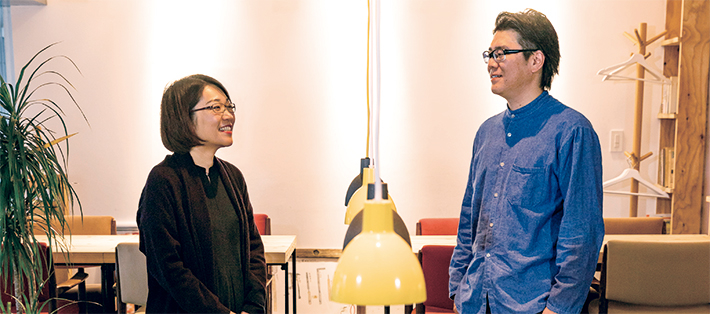
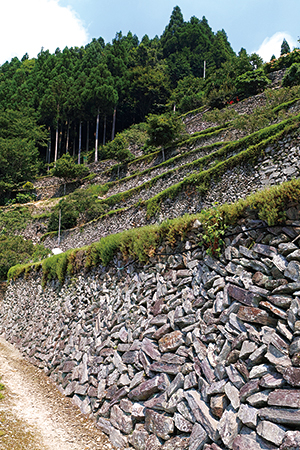
The terraced landscape of
Takagai-no-Ishizumi
Ishizumi, or dry stone walling, is a technique used to create terraced farmland and keep soil from eroding. Stones found in the area are kept mostly in their natural shape and piled ranzum, without a defined pattern. Construction is done using dry masonry, with no mortar or other binding materials.
Since 2009, Associate Professor Junko Sanada has been visiting the stone wall Takagai-no-Ishizumi1 in Yoshinogawa City, Tokushima Prefecture, studying stone walling and working to pass on the technique. Koichiro Sakitani, who established the planning and design firm EAU in 2003 and has worked on numerous public spaces, has known Sanada since they were students. We asked these two, working at the forefront of landscape and civil engineering, to discuss their views on landscape design.
(Held on December 11, 2018 at Hakko-suru Café Kojichu)
Brought together by stone walling
SakitaniThank you for inviting me today. Thinking back, I believe we became acquainted while we were students.
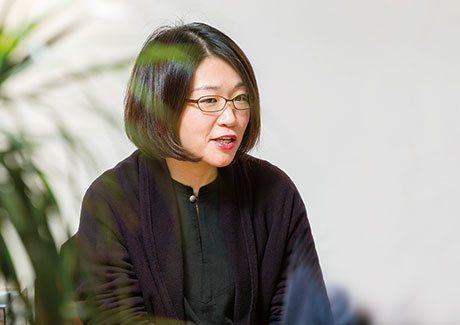
SanadaYes, I was in (then-) Professor Yoshio Nakamura's laboratory at Tokyo Tech, and you were in (then-) Professor Osamu Shinohara's at UTokyo, and our professors were connected as pioneers in the industry.
SakitaniI think the first time we met and spoke properly was at Dobokukei Radio2, which started in 2010. You were already working in stone walling in Tokushima Prefecture.
SanadaWe even went to Takagai-no-Ishizumi to record an episode of Dobokukei Radio.
SakitaniOh, that's right. We've talked on a lot of things, but going back to basics, what made you take up stone walling?
SanadaAfter I took up my post at Tokushima University in 2007, I got my driver's license. So I decided to go somewhere I could only go by car. And when I was looking places up, I found a buckwheat-sowing experience event in the hillside of Yoshinogawa. That happened to be an area famous for its stone walls. Just traveling on the narrow hill paths made me short of breath. The field was slightly sloped toward the valley, and it took strength just to keep the small tiller level. My whole body was sore the next day. It's said that the local population is declining because the terraced farmlands are narrow, making it difficult to bring in machinery. However, I was able to feel for myself that there are difficulties beyond imagination, even before getting to the work. I realized that, even if it's to safeguard the landscape, it is irresponsible to make plans without knowing how difficult day-to-day life there is. I felt that, to consider the situation properly, I would have to try it myself. It's also because the buckwheat field I was working in belonged to Fumio Takagai, a stonemason.
SakitaniTrying it yourself — that's just so like you. A bit different from everyone else.
SanadaThat's how it started. I organized an "ishizumi camp" for students in 2009 that included restoring soil on sloped fields, harvesting grass, and stone walling. I gathered students who would be working with landscapes in the future. The harvested grass is left to rot, and then sown into the field. Chemical fertilizers would make the soil runnier, and that would run off a field on sloped land. I thought they should be aware of this bit of wisdom, that adding fibrous plants for fertilizer helps with retaining soil.
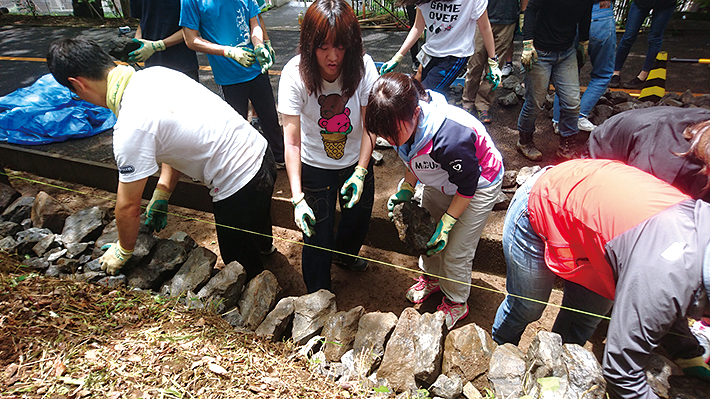
Stone-walling class for first-year students
SakitaniI can definitely relate to that. When I work with historical cultural properties or other public works, I often encounter stone walling. For example, in the Goto Islands in Nagasaki, I witnessed the scenery of small rocks we painstakingly piled up ourselves. I was so drawn to that very primitive stone-walling technology.
SanadaYes, it's the oldest construction method in civil engineering. It's seen in Japan and around the world, but the fundamental mechanics are the same — place the next stone to distribute force over two stones, place it so that the load is in the rear, place the hearting3 behind the facing stones (Figure 1). Following these three principles, the only difference is in the methods chosen due to the shape of the stones in a specific region. I think even the tools are mostly the same across Japan.
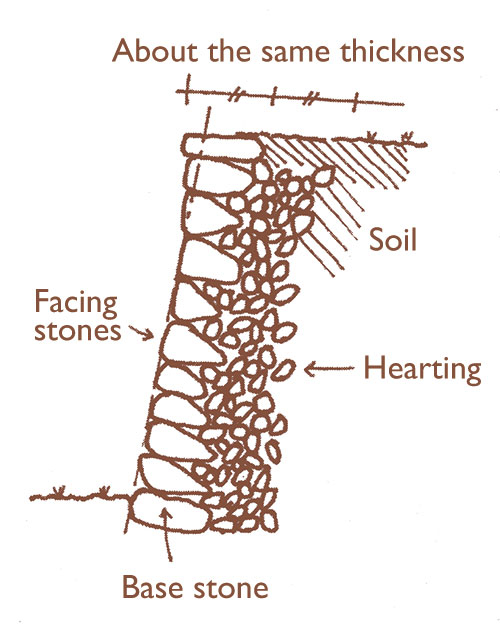
Figure 1 Place hearting behind the facing stones. A thickness about the same as that of the facing stones is optimal. The facing stones are sloped toward the back, and the bottom base stones are half-buried or deeper. A pamphlet by Junko Sanada describes in detail correct stone-walling structure using hand-drawn illustrations.
SakitaniI remember we talked a lot about the current state of stone walling and passing on the technique. There was a project you were doing around 2011 to make a square in the middle of a shopping street in Awa-Ikeda in Miyoshi City, Tokushima Prefecture.
SanadaI was the chair of the landscape council of Miyoshi City, and I asked you to participate in landscape design. We talked about the outlook for stone walling, and you gave me advice about a "stone-walling school" that would match people with the stone-walling technique, the people who want to learn, and the people who need their walls repaired. We also organized a professional training workshop.
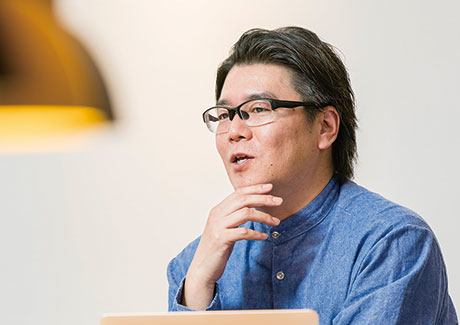
SakitaniI participated in the workshop in the summer of 2017. That was the first time I had ever piled stones, and doing it was completely different from hearing about it. I was able to feel the texture of the stone and the surface more than I had imagined. In this age where people can feel like they've done something, gone somewhere, ate something, where reality is becoming less clear—I was able to feel the realness of my body as part of the earth, working and handling real materials. Before that, around 2003, I took part in repairing revetments along a river in Sukumo City, Kochi Prefecture. The stonemason there was so fascinating. "We look at the stone's eye," he'd say, and he would hook a wire on it using heavy machinery while keeping the center of gravity, and place it perfectly, like magic. He could tell the weight of a stone, just by looking at it.
SanadaTakagai-san, the stonemason in Tokushima, is also very skilled. It would look like he just placed a stone arbitrarily, but it would fit exactly where it should be. When I first started stone walling, I would place a stone where I thought he said to, but he would redo it, or tell me, "this side is the stone's face."
SakitaniYes, they would call it "face" or "eye". It's difficult to explain academically. You have to be used to looking to know what to look for. But little by little, you learn to tell the difference. I think that's important.
The importance of emotional attachment
SanadaStonewalling on farmland is not a craftsman's job. It is something done for livelihood. The objective is to grow crops on the field. The retaining wall is built to create that flat land. Of course, the advantages gained must be balanced against the costs to allocate labor to stone walling. That's why stones available nearby are used, with as little processing as possible. The nature of the stone is different depending on the area, and so is the way it splits. Stone walling methods for different shapes of stone developed and ended up becoming a characteristic of the area.
SakitaniThat's what makes stone walling interesting. In craftsmanship, techniques can be developed with no connection to daily life. On purpose, I suppose. For example, for a castle, however big and however beautifully you can process and use a stone are factors that may come into play. This is not relevant to terraced farmland. What's important is whether you can grow vegetables. Actually, Takagai-san does care about the aesthetics of the stone walling, but in a different way. He builds it there to look nice, because it is seen by people — that's about the extent of his concern. I feel it's different from doing it because of power or for show.
SanadaI think it's just one of the hundreds of tasks required of a farmer. Laboring over it is certainly not a good thing, and in the method is the wisdom for piling stones efficiently. It's really interesting. What left the strongest impression on you when you tried stone walling?
SakitaniI felt, in a way, a hint for becoming one with the landscape. I noticed that I had seen the scenery and had thought I understood it, but I really had not. I think experiencing stone walling would help people to really feel a part of the landscape. For example, even the road in front of this store took human hands to make, but we usually aren't conscious of that. But if we look with the knowledge that the landscape surrounding us is a composite of many, many thought processes, we can't fail to appreciate it. That is what stone walling teaches, the environment that you're living in.
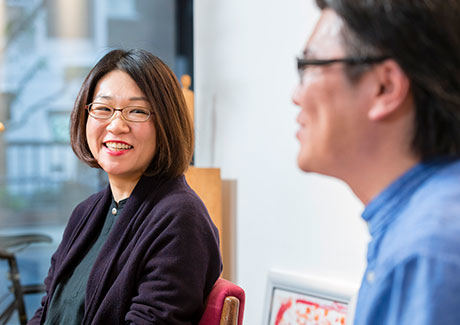
SanadaThat sounds connected to your stance on things. I feel that you value the process in your design work. What is it that you are particular about or that you always value when it comes to civil engineering?
SakitaniIt's really simple. My wish is that people who make something and the people who use something take interest in that something. We live by interactions with society, so give attention to that. In the process of planning and designing, I look for how much I can create opportunities for people to be involved in the area. I do this intentionally. By having a person involved even a little, I feel that results in an emotional attachment to the place or undertaking. It stays with them as a memory.
SanadaWith the square in Miyoshi City, too, in the end, we laid the lawn together with the residents and made a flower bed with the children. Speaking of involvement, one of the classes for first-year undergraduates is stone walling, on university grounds.
SakitaniWow, that's a great class.
SanadaWe spent two days on the weekend piling the stones, and it rained heavily three days later. One of the comments at a later class was, "I was thinking about whether the stones stayed intact." Until then, infrastructure was a given, something that had always existed since they were born. They likely hadn't considered that there was someone who built it. But once they piled stones themselves, they began to feel like its caretakers, wondering "Is it OK?". I realized how influential it is to be involved. For example, in the Meiji period, even a new bridge being built was of great significance. Being able to cross to the other side regardless of weather made a real change to daily life. Today, when things are mostly established, I think people are not as conscious about infrastructure.
SakitaniI agree. Infrastructure, of course, but it's true for clothing, food, and shelter, as well. I think experiencing them in person, even a little, would change the way people view them. It is so ordinary to be surrounded by safety and security in life that we hear comments like "why is there a step here?" But a barrier-free path is filled with wisdom, creativity, and technique of people. And even if you read lots of books and feel like you understand, these can still be hard to notice. Doing something in person means you gain things through real experience, and I think what's interesting about stone walling is that you get to share that with others.
Building future relationships between the environment and people
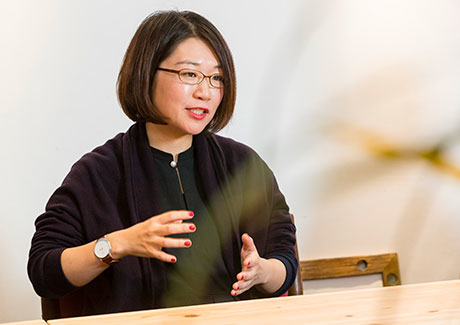
SanadaThe thought process for landscapes, including infrastructure, is certainly different for rural and urban areas. For example, green spaces had been planned as to make green a part of daily life, green with a warm closeness that could be felt. It wasn't theoretical planning, like looking at a map from above. However, volume came to be prioritized since the early 1970's. With emphasis put on the quantified area of parks or the number of trees lining a street, there was an increase in scenery like a boulevard lined with what were, in fact, just heavily-pruned4 trunks. I think we need to consider what kind of life green is necessary for.
SakitaniI feel that green in urban areas are always controlled. They are planted according to regulations designed for humans and heavily pruned if they get in the way. Such plants are under the rule of humans. However, when we go to rural areas, the weight shifts to the natural environment, and regulation is a bit different. There seems to be a difference in the superiority relationship making the rules necessary to keep living.
SanadaYes, first, nature has its processes, and then comes how humans are going to live there. Landscape engineering has developed in Japan as a result of building expressways, so landscape as something to control has been the focus. Rural landscapes is a relatively new field. That's definitely not going to work unless the difference in the superiority relationship is recognized.
SakitaniTrying to handle nature at the level of handling urban areas probably won't work. In rural areas, where you gain something from nature, it's important to value nature, while at the same time, not exploit it. That connects with your research, too, I think.
SanadaYes, farming isn't sustainable when too many chemicals and fertilizers are used. Crops may grow for a while, but microorganisms and insects in the soil decrease, the land becomes less fertile or polluted, and no one knows how many years that harvest will continue. We have to consider the natural regeneration powers that make the soil fertile. To take into account that the use of agricultural land on top of the stone walling is happening based on the cycles of nature and to consider both elements together in rural planning is a challenge for this age of regional revitalization.
Approximately half of the municipalities in Japan are designated underpopulated areas, and agricultural land in hilly and mountainous areas account for as much as 40% of all agricultural land. Industrialization and optimization of agriculture is progressing in flat lands, but for my research, I have chosen agriculture in less convenient, more diverse environments.
SakitaniIt's motivating to be able to make contributions in research that will equally contribute to the future.
SanadaYes, it's a field which will only keep changing. Rural landscapes, in particular, have gained attention because of the law protecting Important Cultural Landscapes5, which came into effect in 2005. However, this is dependent on the old valuation as traditional scenery. Now that sustainable development goals (SDGs) are a global standard, we need take how rural areas used to be and the techniques inherited and redefine them as new values, such as sustainability, fit for the way society is becoming. I feel that this is not just nostalgia or a study of the old to gain new knowledge. There is value that we need for the future.
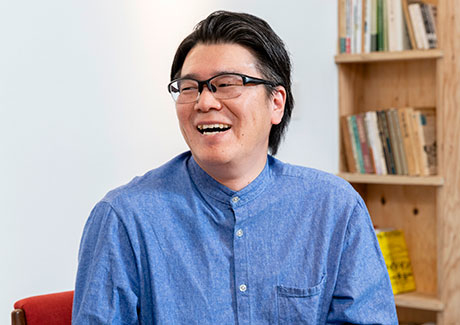
SakitaniI also feel there is a need to do things differently than before, in this age with great changes. Trial-and-error with that goal is exciting. Organizing the requirements and producing an output design incorporating them all. Drawing out the optimal solution for a land certainly requires human involvement, so I am now careful about balance so as to not favor just one opinion.
SanadaFor example, if population decline continues, tax income decreases, and there comes a time when we all have to maintain public plazas and structures ourselves, the position itself occupied by infrastructure must undergo great change. It looks like you're taking on that challenge.
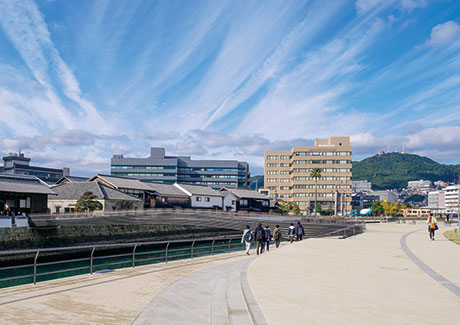
Dejima Main Gate Park in Nagasaki City,
a work by Koichiro Sakitani
Photo: Orient Ing (Kennichi Kojima)
SakitaniYes, that's true. I was involved in a project in Nagasaki City, Nagasaki Prefecture for the bridge and a park at Dejima. After its completion, residents of the city began wiping and sweeping it every two weeks. That kind of involvement creates an emotional attachment, as if the bridge and park belong to them personally. It's one of the new ways of being involved with infrastructure.
SanadaThe point is, how much they think of it as "theirs." If people are indifferent about infrastructure, they won't help keep it clean. From your point of view, do you see anything like a trend in that?
SakitaniIt feels like the landscape and architecture industry in Japan is more conscious of "bringing about things" than crafting things. But just following trends is not enough. Crafting things is still important. We have to be conscious of craft as well.
SanadaWhile we're talking about rural landscapes, in Italy, a growing number of people are wanting to live in harmony with nature, in a cycle. In particular, university graduates moving to the countryside to start agribusinesses have made the news. The proportion of university students there is less than in Japan, and it seems to be having an impact that these graduates of high social standing are taking up agriculture.
SakitaniI believe you studied in Italy for a year as a student. Have you discovered anything thanks to your international connections?
SanadaWhen I was a study-abroad student there, I was working with city landscapes. There wasn't much being done about the rural landscape in Italy at that time, and my interest at the time was also city landscapes. In Italy, discussion and research on rural landscapes started in the 2000s, and I also started to focus on rural landscapes after leaving for my post at Tokushima University. It was a total coincidence. After that, I was able to get to know people doing or researching stone walling when I went to Italy for research in 2015 for three months. There was an international conference for terraced farmland in 2016, and we held a stone-walling camp in 2017, with most of the attendees being Tokyo Tech students. In June of this year, we were invited to represent Japan in a stone-walling competition. Most of the stone-walling and terraced-farmland professionals that I have met in Italy are highly conscious of the environment. Of course, it's because that's the viewpoint from which they are studying stone walling, but my impression is that many of them are conscious of minimizing the load on the environment in their daily diet, or otherwise connect their professional lives with their daily lives.
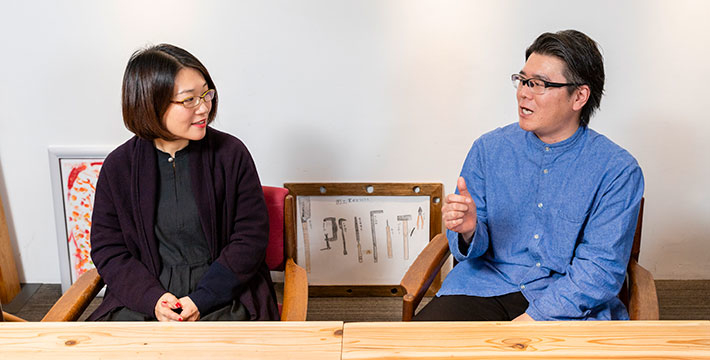
Encounters broaden design
SanadaWith stone walling and other rural landscapes, I don't design so intentionally. Judging whether a design is good or bad is greatly affected by the person's values. The rural landscape reflects the way of life and the philosophy of the people who are farming and living in a sustainable way. I feel that we have to create a society that values that as beauty. Of course, a stonemason may give the work a nice appearance as a courtesy, but I feel we need to "become able to appreciate that aesthetic" as opposed to "having to make something that is aesthetically pleasing."
SakitaniPursuing "good design" is difficult. For example, fermentation is the theme of EAU's café Kojichu. Fermentation is something good for people that, by the work of things we can't see, becomes good food. I think good design is like that, when society is improved in a similar way. Though it's commonly misunderstood, it's not that "if something is produced, a good society will follow." If it feels pushy, people won't feel like they want to go. Like people, places and landscapes also need something unguarded, something profound about them. I think it's important how those qualities are present in things so that people are incited to want to go, to want to do something there. Just like there are a lot of things wanting for this café! (laughs)
SanadaI've been meaning to ask — why did you choose this location (Hongo) to open a café adjoining your office?
SakitaniI've been indebted to Hongo since my student days, so it started with me wanting to give back to this community. It's not a field in a rural area, but I've been blessed by this environment and benefited from it for over ten years. In the process of giving back to the community, I thought that maybe we would encounter opinions and ideas rooted in the reality of this area and community that we're working with right now. As we followed that thinking, it ended up being in the form of a café.
SanadaI see. Landscapes and civil engineering really are intimately related to society, so you can't say all it requires is calculation, though it's engineering. Even with an embankment, building it strong is not the only factor. Designing it without knowing the circumstances of the community being protected could upset the landscape and routes of passage. Studying civil engineering means that you gain the power to make huge changes to space, so I think it would be a very difficult field for someone who doesn't take interest in society.
SakitaniThat's a thought for students working toward civil engineering. I feel that there is no way to avoid working on the problems of society. I take interest in the person in front of me, the person I speak with for work. For example, if the population has declined where that person lives and industry has also waned, but that person has to keep living there, I feel I want to do something about that. If I can tweak the mechanism of the world a little and bring a good output, it could turn out well for the people there. That's what I think about as I work.
SanadaIt sounds like everything you do is based on being interested in the person in front of you and paying attention to the community or area.
SakitaniYes, that's true. At a project we did in Sado City, Niigata Prefecture, we designed a plaza with keen attention to what the local people were thinking of, and a concert was held there after its completion. I've also heard from patrons of this café that they would like a concert. In ways like that, I want to keep treasuring how people feel when they visit the place and how they'll connect that feeling to their next actions.
SanadaPaying attention to people could be called the first step to entering the world of civil engineering or architecture. In university, too, I recommend diving in if something seems interesting. For me, I started going to a lab during the summer break of my second year in undergraduate study. Usually, students are assigned in the fourth year, but my experience was that I was able to open up different paths because I frequented a lab that I became interested in after attending a lecture. You studied at Hokkaido University and the University of Tokyo. Did you have any experiences that left an impression on you?
SakitaniThough they were both civil engineering departments, the cultures were totally different at HU and UTokyo. In addition, I think that a role a university plays is how much of your future potential you can encounter there. In that sense, when I came from HU to UTokyo, I felt definitely more points of contact with society at UTokyo.
SanadaTokyo Tech is also in the capital region, and that holds true here, too. There are many types of people, not just in civil engineering or architecture, and, similar to how we did, there may be an opportunity to meet an interesting professor.
SakitaniI hope students look forward to meeting people who will extend their potential, believe in the path that interests them, and strive in their chosen path.
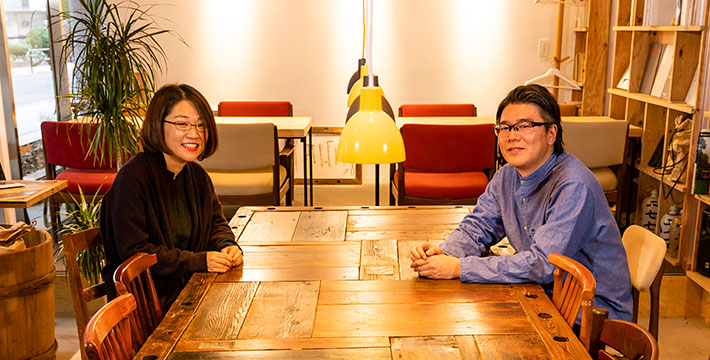
1 Takagai-no-Ishizumi
The name of the area is Ogami, but the site is called "Takagai-no-Ishizumi" or "Takagai Region."
2 Dobokukei Radio
Meaning "department of civil engineering radio," an internet radio station broadcasting varied topics related to civil engineering, landscapes, urban development, and design, and the like. Sakitani and Sanada are core members involved in its planning and administration.
3 Hearting
Small stones placed behind facing stones. Its roles are to anchor the facing stones and to function as a drainage layer.
4 Heavily pruned
Being pruned by cutting thick branches short or cutting off several branches and buds. It is done to keep trees compact, but the stress on trees is great, and there is risk of branches dying.
5 Important Cultural Landscapes
Cultural landscapes located in a Landscape Planning Area or Landscape District of Japan. They are cultural properties that have been selected by the national government as especially important among those protected by prefectural or municipal governments.
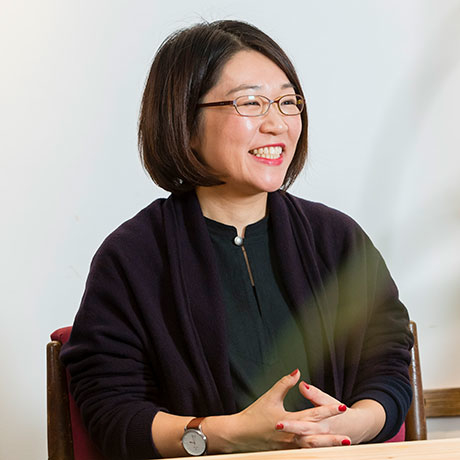
Junko Sanada
Associate Professor, School of Environment and Society, Tokyo Institute of Technology
Studied in Italy in 1996 under the Vulcanus program (an internship program by the EU-Japan Centre for Industrial Cooperation allowing Japanese engineering students to study in an EU member state). Graduated from the Department of Social Engineering, School of Engineering, Tokyo Institute of Technology in 1998. Received a master's degree from the Department of Social Engineering, Graduate School of Decision Science and Technology in 2000. Received a Doctor of Engineering degree from the Department of Value and Decision Science, Graduate School of Decision Science and Technology in 2005. Became an Assistant Professor at the Institute of Technology and Science, Tokushima University in 2007. Associate Professor at Tokyo Tech since 2015. Specializes in landscape engineering, historical green space planning, and rural landscapes. Publications include Toshi no midori wa dou aru bekika [How Urban Green Should Be] and Zukai: Dare demo dekiru ishizumi nyuumon [Illustrated: Anyone Can Do Stone Walling — An Introduction] in December 2018. Faculty of the Department of Civil and Environmental Engineering, School of Environment and Society.
Sanada Lab
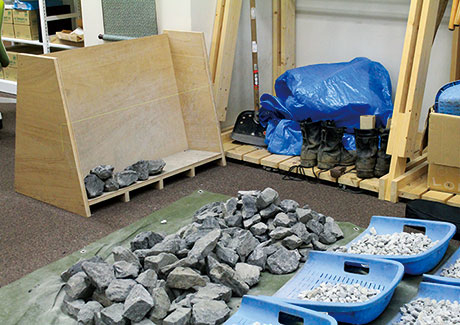
Main research themes include historical approaches covering urban planning and green space planning in Japan before World War II, values and systems in agricultural landscapes and the revitalization of rural areas, and stone walling of terraced farmland making up the rural scenery of hilly and mountainous regions. The value of stone walling for the modern day and passing on its technique is regaining attention in Europe in recent years, and Sanada Lab takes various approaches to the subject in their research.
Sanada Lab

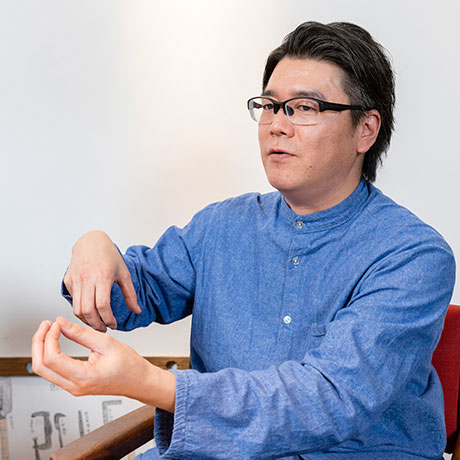
Koichiro Sakitani
Representative Director, EAU Co., Ltd.
Graduated from the Department of Civil Engineering, Faculty of Engineering, Hokkaido University in 1999. Completed a master's degree at the Department of Civil Engineering, School of Engineering, University of Tokyo in 2001. Worked at Nippon Koei, Co., Ltd. from 2001 to 2002. Established EAU and became its representative in 2003. Lecturer at Kokushikan University since 2008. Landscape advisor for Bunkyo Ward and lecturer at Tohoku University since 2011. Representative Director of EAU and lecturer at Tokyo University of the Arts since 2015. Major works include Nagisa Seaside Park in Atami City, Central Bridge in Nagasaki City (Good Design Award recipient), The Old Sado Mine Plaza for the Group of Maintenance Facilities in the Kitazawa Area and in Oma Port in Niigata Prefecture (Good Design Award recipient), and Dejima Main Gate Park in Nagasaki City.
. Any information published on this site will be valid in relation to Science Tokyo.


















